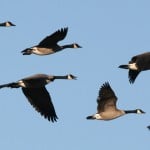English collective nouns: collectively, a little strange
 A collective noun is the word used to define a group of something, usually animals. Common collective nouns such as “herd”, “flock”, “pack” or “swarm” are well-known, but English has a vast collection of lesser-known collective nouns for certain creatures.
A collective noun is the word used to define a group of something, usually animals. Common collective nouns such as “herd”, “flock”, “pack” or “swarm” are well-known, but English has a vast collection of lesser-known collective nouns for certain creatures.
For example, “a murder of crows”, “a bed of eels”, “a parliament of owls”, “an army of caterpillars”, “a cluster of spiders”, and “a streak of tigers”.
Some collective nouns even change depending on the nature of the group in question. For example, geese are usually referred to as a “flock” or a “gaggle”, but these terms should only be used if the geese are on land. In flight, they should be referred to as a “skein”; if they are flying close, then it’s “a plump of geese”.
For a detailed list of the appropriate collective nouns to use in any situation, take a look at the Wikipedia entry.
English is not unique in using different terms to define different groups. Japanese, for example, takes it even further with measure words, as described in a previous post:
Unfortunately, however, it’s not as simple as all that. Like Chinese and Korean, Japanese incorporates into ‘measure words’ (josuushi) into its counting system. Whereas in English, I could simply say “there are thirty four of them”, in Japanese you need to add a suffix to the number that is specific to the object, person, event, or action you’re counting. Sadly, there are several hundred of these, and they simply have to be learnt. The josuushi used depends on the qualities of what you’re counting – long, thin objects such as pencils, roads, rivers or bottles use hon or pon; but thin, flat objects such as sheets of paper, photos or plates use mai. Thus, being able to say that “there are two dogs” will not necessarily allow you to say “there are two cars”. There are around 30 commonly-used josuushi, and plenty more that are used sporadically.
